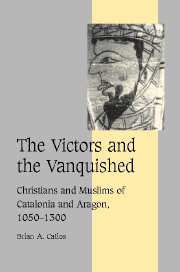Book contents
- Frontmatter
- Contents
- List of figures
- List of maps
- List of tables
- Acknowledgments
- Note on the citation of sources, dates, places, and names
- Glossary
- List of abbreviations
- INTRODUCTION
- Part I Muslim domination of the Ebro and its demise, 700–1200
- Part II Muslims under Christian rule
- Part III INDIVIDUAL AND COMMUNITY IN THE CHRISTIAN EBRO
- Conclusions
- MUDÉJAR ETHNOGENESIS
- Appendices
- Select bibliography
- Index
- Cambridge Studies in Medieval Life and Thought Fourth series
MUDÉJAR ETHNOGENESIS
Published online by Cambridge University Press: 08 January 2010
- Frontmatter
- Contents
- List of figures
- List of maps
- List of tables
- Acknowledgments
- Note on the citation of sources, dates, places, and names
- Glossary
- List of abbreviations
- INTRODUCTION
- Part I Muslim domination of the Ebro and its demise, 700–1200
- Part II Muslims under Christian rule
- Part III INDIVIDUAL AND COMMUNITY IN THE CHRISTIAN EBRO
- Conclusions
- MUDÉJAR ETHNOGENESIS
- Appendices
- Select bibliography
- Index
- Cambridge Studies in Medieval Life and Thought Fourth series
Summary
ce n'est point la forme, soit du corps, soit de ses parties, qui donne lieu aux habitudes et à la manière de vivre des animaux; mais … ce sont, au contraire, les habitudes, la manière de vivre, et toutes les autres circonstances influentes qui ont, avec le temps, constitué la forme du corps et des parties des animaux. Avec des nouvelles formes, des nouvelles facultés ont été acquises, et peu à peu la nature est parvenue à former les animaux tels que nous les voyons actuellement.
Jean-Baptiste Lamarckthe person who moves through different pluralities in a pluralistic society functions in different modes, even simultaneously.
R. D. LaingThe Christian domination of the Ebro was not achieved in any profound sense with the surrender of the region in the late eleventh and early twelfth centuries. On the contrary, the military conquest initiated a process of social evolution and cultural transformation which continued until the eventual expulsion of the moriscos in the seventeenth century. The initial period of occupation was marked by a willingness on the part of the Christian powers to extend far-ranging autonomy to the conquered peoples, who became tributaries, and as the demographic balance shifted in the Christians' favor, and the Crown developed more sophisticated legal and administrative apparatus, the Muslims were gradually drawn into “Occidental” institutions as participants and subjects. Thus, the Islamic society of the region was not destroyed by the conquest, but had re-emerged as a mudéjar society by the thirteenth century.
- Type
- Chapter
- Information
- The Victors and the VanquishedChristians and Muslims of Catalonia and Aragon, 1050–1300, pp. 390 - 408Publisher: Cambridge University PressPrint publication year: 2004

